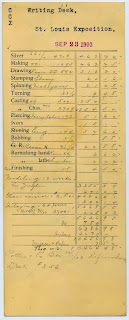 |
| Architect's drawing of the new Gorham plant, about 1890. |
After the move, Gorham hired a new chief designer, William C. Codman, a 52-year-old Englishman. Codman was the chief designer for the pieces Gorham made for the Columbian Exposition in Chicago in 1893, where Gorham won 55 medals! He also designed the Chantilly flatware pattern in 1895, which has always been Gorham's best seller. Codman would go on to design over 50 flatware patterns during his 23 years at Gorham, but this was clearly the winner and is still made today. It was the most popular sterling flatware pattern made in the 20th century, by any company.
 |
| Lady's writing table and chair, Gorham, 1903. |
Among the many beautiful pieces designed by Codman was a lady's writing table and chair made in 1903 to exhibit at the 1904 Worlds Fair in St. Louis. (That was the "Meet Me in St. Louis, Louie" fair.) There was also a 16-piece silver desk set that went with it.
It's a real tour de force and was intended to showcase the incredible talent of the Gorham artisans. Click here to examine the desk in more detail.
 |
| William Codman signed the piece. |
The desk is particularly remarkable in its use of silver, ivory, and mother of pearl inlay in the challenging surface of ebony and rosewood. The form of the desk is 18th century French rococo, the women on the drawers and legs very Art Nouveau, and the arabesques on the top are traditional Hispano-Moorish.
 |
| Costing slip for the desk. |
The back border on the top includes morning glories for morning and poppies for evening, as well as an owl to represent wisdom, and perhaps inspire the writer?
There are about 50 pounds of silver in the desk and chair, and over 12,000 hours went into the creation of this work. The cost was almost $13,000; the costing slip for the desk alone is shown here. The price was set by Gorham at $18,000 for the desk and chair, plus another $2,000 for the desk set.
The pieces were awarded the Grand Prix for silversmithing in St. Louis, and they were also exhibited at the Panama-Pacific International Exposition in San Francisco, where they won the gold medal.
 |
| Lady Esher and daughter, 1932. |
Antoinette died in 1965, but had unloaded the desk and chair prior to that, since the pieces turned up at a Christie's auction in London in 1954. It was purchased for $3,500 by Mr. & Mrs. Frederick Thurber of Providence, descendants of Gorham Thurber, a former business partner of John Gorham, and they donated it to the RISD Museum--bringing it full circle back to its place of origin.
(to be continued)
Illustration Credits and References
Photo of the writing table from the RISD Museum website.
Photo of the signature and the costing slip from the Brown Digital Repository.
Photo of Lady Esher from ancestry.com.
New York Times, "Miss Hecksher to wed O.S.B. Brett," August 29, 1912.
Architect's drawing of the new Gorham plant, plus an exhaustive history of Gorham can be found in the book Gorham Silver by Charles H. Carpenter, Jr. (Revised edition published 1997 by Alan Wofsy Fine Arts, San Francisco.)
No comments:
Post a Comment